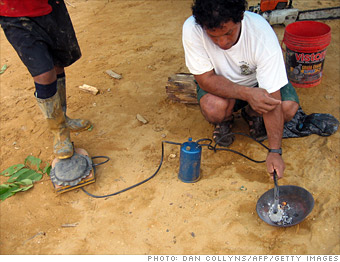
A gold miner in southeast Lima, Peru, in the forest bordering with Brazil .
2009 GDP Growth: 1%
Population: 28.7 million
2010 Estimated GDP Growth: 6%
Peru weathered the 2008 global financial crisis well and was one of the few Latin American countries that saw positive growth rates during the worst of it (about 1% in 2009).
The third-largest country in South America, Peru owes its growth to government efforts to reform its economy in the 1990s and measures taken in 2001 to promote trade and attract investments. For the past seven years, the country has averaged 6.8% annual growth. As with Colombia, Peru's financial systems are much less complex than those of more developed economies, which helped shield them from the worst. Though financial services in both countries have grown, tighter financial regulations have forced banks to behave much more conservatively.
Mining, exports, and private investments have also driven Peru's growth. The country is the world's top producer of silver, second in zinc, third in copper and tin, fourth in lead, and sixth in gold. With the U.S., China, Switzerland, Canada, Japan, and the European Union as its major trading partners, Peru's exports reached $31.2 billion in 2008 -- more than half (or 63%) of which was attributed to high prices of minerals.
NEXT: Singapore
Last updated July 01 2010: 4:35 PM ET
Source: Population figures from U.S. State Department; GDP numbers from International Monetary Fund
